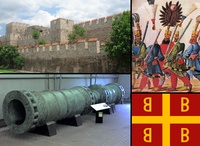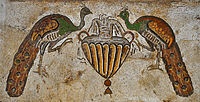-
Use Cases
-
Resources
-
Pricing
Religious and Cultural Developments
Byzantine Influence on Eastern Orthodox Christianity
300 - 1499
% complete
First Council of Nicaea
May 20, 325
% complete
The First Council of Nicaea was a gathering of bishops and religious leaders in the Byzantine Empire in 325. It was convened by Emperor Constantine to address the Arian controversy, which questioned the divinity of Jesus Christ. At the council, the Nicene Creed was established, affirming the divinity of Christ and condemning the Arian beliefs. This council had a significant impact on the development of Christian doctrine and played a crucial role in the history of the Byzantine Empire.
Image source: First Council of Nicaea

Adoption of Orthodox Christianity as State Religion
380
% complete
In 380 AD, Emperor Theodosius I issued the Edict of Thessalonica, making Orthodox Christianity the state religion of the Byzantine Empire. This was a significant event as it cemented Christianity's position as the dominant religion in the empire and set the stage for the close relationship between the imperial government and the Orthodox Church.
Council of Chalcedon
Oct 8, 451
% complete
The Council of Chalcedon was a church council held from October 8th to November 1st, 451 AD, at Chalcedon, a city in Bithynia. The council was called by Emperor Marcian to address the theological dispute between the followers of Dioscorus, the Patriarch of Alexandria, and those who supported the views of Pope Leo I. The main purpose of the council was to affirm the orthodox Christological doctrine and to condemn the teachings of Eutyches, who believed that there was only one nature in Christ, a mixture of divine and human elements. The council declared that Christ had two distinct natures, divine and human, united in one person without confusion, change, division, or separation. This formulation became known as the Chalcedonian Definition and is still recognized by the Eastern Orthodox, Roman Catholic, and many Protestant churches today.
Image source: Council of Chalcedon

Construction of Hagia Sophia
532 - 537
% complete
The Construction of Hagia Sophia was a project commissioned by the Byzantine Emperor Justinian I in the 6th century. It started in 532 and was completed in 537. The architectural marvel was designed by two Greek architects, Isidore of Miletus and Anthemius of Tralles, who used innovative techniques and materials. The construction of Hagia Sophia was a symbol of the wealth and power of the Byzantine Empire, as well as a testament to the empire's Christian faith. The building has had a significant influence on the development of architecture and continues to be a major tourist attraction in present-day Istanbul, Turkey.
Image source: Byzantine architecture

Iconoclasm Controversy
726 - 843
% complete
The Iconoclasm Controversy was a dispute within the Byzantine Empire over the use of religious icons in worship. It began in 726 and lasted until 843. The controversy involved conflicting beliefs and practices regarding the use and veneration of icons, with some factions advocating for their use and others opposing it. The controversy had profound social, political, and religious implications and resulted in the destruction of many icons and the persecution of their supporters. It was ultimately resolved in 843 with the restoration of icon veneration.
Image source: Byzantine Iconoclasm

Great Schism between Eastern and Western Christianity
1054
% complete
The Great Schism between Eastern and Western Christianity, also known as the East-West Schism, was the division of Christianity into the Eastern Orthodox Church and the Western Catholic Church. It occurred in 1054 when Pope Leo IX sent a delegation to Constantinople to address several theological disagreements with the Eastern Church. The talks broke down and mutual excommunications were issued, formalizing the split. This schism had lasting impacts on the cultural, social, and political landscape of Europe and the Byzantine Empire.
Founding and Early Years
Founding of Constantinople
May 11, 330
% complete
The city of Byzantium is founded by Greek colonists led by Byzas on the European side of the Bosporus. It is later renamed Constantinople and becomes the capital of the Eastern Roman Empire.
Image source: Constantinople

Economic and Technological Advances
Silk Production and Trade
500 - 1199
% complete
Silk Production and Trade was a major industry in the Byzantine Empire from the 6th century to the 12th century. The Byzantines were the main producers of silk in Europe during this time period. Silk was produced through a complex process that involved raising silk worms, harvesting their cocoons, and weaving the silk fibers into fabric. The Byzantines held a monopoly on silk production and tightly controlled the trade of silk within their empire. Silk was highly valued and sought after, both for its luxurious feel and for its association with wealth and status. The trade of silk played a significant role in the Byzantine economy, as it was a major export item that brought in substantial revenue. Silk was also used as a diplomatic gift, given by the Byzantines to foreign rulers to demonstrate their wealth and power.
Image source: History of silk

Byzantine-Arab Trade Routes
500 - 1099
% complete
Byzantine-Arab Trade Routes were a series of trade routes established between the Byzantine Empire and the Arabs from the 5th century to the 11th century. These trade routes facilitated the exchange of goods, ideas, and culture between the two civilizations. The routes stretched from the Eastern Mediterranean to the Arabian Peninsula and beyond, allowing for the trade of spices, silk, precious metals, and other valuable commodities. The trade routes also served as a conduit for the spread of Islam and the diffusion of knowledge and technology. The trade between the Byzantines and the Arabs played a significant role in shaping the economies and societies of both civilizations.
Political and Military History
Byzantine-Italian Wars
500 - 1099
% complete
The Byzantine-Italian Wars were a series of conflicts between the Byzantine Empire and various Italian city-states and kingdoms during the Early Middle Ages. The wars lasted from 500 to 1099 and were primarily fought over control of territories in Italy and the Mediterranean. The conflict involved numerous military campaigns, sieges, and diplomatic negotiations. The wars resulted in shifting alliances, territorial gains and losses, and significant cultural and political exchanges between the Byzantine Empire and Italy.
Byzantine-Avar Wars
500 - 699
% complete
The Byzantine-Avar Wars were a series of conflicts between the Byzantine Empire and the Avar Khanate that took place from 500 to 699. The Avars were a nomadic people from Central Asia who established a powerful Khanate in Eastern Europe. The wars were characterized by frequent raids, sieges, and battles between the two powers. The Byzantine Empire, led by various emperors, sought to defend its territories and maintain control over the Balkans. The Avars, on the other hand, aimed to expand their influence and plunder Byzantine territories. The wars resulted in significant loss of life and resources, as well as territorial changes. The Byzantines were able to repel the Avar attacks and maintain their control over key regions, but the conflicts strained their military and economic resources. The wars also had a profound impact on the demographics and cultural landscape of the affected regions. Ultimately, the Byzantine-Avar Wars played a role in shaping the future political and cultural developments in Eastern Europe.
Image source: Avar–Byzantine wars

Byzantine-Lombard Wars
500 - 699
% complete
The Byzantine-Lombard Wars were a series of conflicts between the Byzantine Empire and the Lombards, a Germanic people who invaded Italy. The wars lasted from 568 to 751, with intermittent periods of peace. The Lombards initially established a kingdom in Italy, but the Byzantine Empire sought to regain control of the peninsula. The wars were characterized by sieges, territorial disputes, and alliances with other Germanic tribes. The Byzantines eventually succeeded in reestablishing their authority in Italy, while the Lombards were gradually assimilated into the local population.
Image source: Byzantine–Lombard wars

Byzantine-Persian Wars
502 - 628
% complete
The Byzantine-Persian Wars were a series of conflicts fought between the Byzantine Empire and the Sassanian Persian Empire from 502 to 628. The wars were mainly fought over territorial disputes and religious differences, with both sides seeking to expand their influence and control over the region. The Byzantines were led by several emperors, including Anastasius I, Justinian I, and Heraclius, while the Persians were ruled by the Sassanian dynasty. The wars saw several key battles and campaigns, including the Byzantine reconquest of Italy, the Persian recapture of Jerusalem, and the ultimate defeat of the Persians by Heraclius, who restored the True Cross to Jerusalem in 628.
Reign of Emperor Justinian I
527 - 565
% complete
Reign of Emperor Justinian I (527 - 565) - Justinian I, also known as Justinian the Great, was the Byzantine emperor from 527 to 565. He is often considered one of the greatest emperors in Byzantine history. During his reign, Justinian sought to restore the Roman Empire by reconquering the lost territories in the west, including Italy and parts of North Africa. He was also known for his codification of Roman law, known as the Corpus Juris Civilis, which had a significant influence on the development of legal systems in Europe.
Image source: Justinian I

Codification of Roman Law as "Corpus Juris Civilis"
529
% complete
The Codification of Roman Law as 'Corpus Juris Civilis' is a compilation of Roman legal principles created under the direction of Byzantine Emperor Justinian I. It consisted of three parts: the 'Digest', the 'Institutes', and the 'Code', along with the 'Novels' which were later additions. The Codification clarified and standardized Roman law, and had a significant influence on legal systems throughout Europe.
Image source: Institutes (Justinian)

Justinian's Code of Laws
529
% complete
Justinian's Code of Laws was a comprehensive compilation of Roman laws issued by the Byzantine Emperor Justinian I in 529. It consisted of four main parts: the Codex Justinianus, a collection of imperial legislation; the Digesta, a compilation of legal opinions and interpretations; the Institutiones, a beginner's guide to the law; and the Novellae Constitutiones, new laws issued after the completion of the Codex. Justinian's Code of Laws had a significant impact on the development of Western legal systems, and it served as the foundation for Byzantine legal practice for centuries to come.
Image source: Corpus Juris Civilis

Nika Riots in Constantinople
Jan 13, 532 - Jan 18, 532
% complete
The Nika Riots were a series of violent uprisings that took place in the city of Constantinople (modern-day Istanbul) in January 532. The riots were sparked by a controversy between two rival factions of chariot racing supporters, the Blues and the Greens, but quickly escalated into a full-scale rebellion against the Byzantine emperor Justinian I. The riots resulted in widespread destruction and loss of life, with much of the city being set on fire and thousands of people killed. The rebellion was eventually suppressed by Justinian's forces, but the Nika Riots had a lasting impact on the Byzantine Empire, leading to significant political and social changes.
Image source: Nika riots

Byzantine-Arab Wars
600 - 1099
% complete
The Byzantine-Arab Wars were a series of conflicts between the Byzantine Empire and various Arab caliphates from the 7th to the 11th centuries. These wars were primarily fought over territorial control in the eastern Mediterranean region, including the Byzantine provinces of Syria, Palestine, and Egypt. The wars began in 634 when the Arab Rashidun Caliphate launched a massive invasion of the Byzantine Empire. Over the next four centuries, the Byzantines and the Arabs fought numerous battles and skirmishes, with both sides experiencing periods of success and setbacks. The wars ended in 1099 when the Byzantines successfully repelled the last major Arab invasion of Anatolia, solidifying their control over the region.
Byzantine-Bulgarian Wars
600 - 1399
% complete
The Byzantine-Bulgarian Wars were a series of conflicts between the Byzantine Empire and the Bulgarian Empire. These wars took place from 600 to 1399 and were characterized by territorial disputes and power struggles between the two empires. The wars involved multiple battles and sieges, with both sides gaining victories and suffering defeats. The Byzantine Empire often sought to control Bulgarian territories and prevent Bulgarian expansion, while the Bulgarian Empire aimed to assert its independence and expand its influence. These wars played a significant role in shaping the political and territorial dynamics of the Balkans during the Middle Ages.
Image source: Byzantine–Bulgarian wars

Byzantine-Abbasid Wars
600 - 899
% complete
The Byzantine-Abbasid Wars were a series of conflicts between the Byzantine Empire (Eastern Roman Empire) and the Abbasid Caliphate during the 7th to 9th centuries. The wars were primarily fought over control of territories in the Eastern Mediterranean, including the rich provinces of Syria, Palestine, and Egypt. The conflict resulted in shifting borders and power dynamics between the two empires, with both sides experiencing victories and defeats throughout the centuries.
Byzantine-Sassanian War
602 - 628
% complete
The Byzantine-Sassanian War was a protracted conflict between the Eastern Roman (Byzantine) Empire and the Sassanian Persian Empire. It lasted from 602 to 628 and resulted in significant territorial losses for both sides. The war was marked by numerous military campaigns and sieges, including the famous siege of Constantinople by the Sassanians in 626. Ultimately, the conflict ended with the Byzantine victory and the collapse of the Sassanian Empire.
Image source: Byzantine–Sasanian War of 602–628

Arab-Byzantine Wars Begin
634
% complete
The Arab-Byzantine Wars were a series of conflicts between the Arab Muslim armies of the Rashidun and Umayyad caliphs and the Byzantine Empire. The wars began in 634 with the Muslim conquests of the Levant and Egypt, and continued until the final Byzantine–Arab war in 750. These wars were a critical part of the early Islamic expansion and resulted in significant territorial gains for the Arab forces, as well as the loss of several Byzantine provinces.
Image source: Arab–Byzantine wars

Byzantine-Croatian Wars
700 - 899
% complete
The Byzantine-Croatian Wars were a series of military conflicts between the Byzantine Empire and the Kingdom of Croatia. The wars lasted from 700 to 899 and were primarily fought over control of territories in the Balkans. The conflict saw multiple Byzantine and Croatian rulers come to power, each attempting to gain control of key cities and regions. The wars ultimately ended with a Byzantine victory, solidifying their control over the Balkans and weakening the Kingdom of Croatia.
Byzantine-Hungarian Wars
800 - 1099
% complete
The Byzantine-Hungarian Wars were a series of conflicts between the Byzantine Empire and the Kingdom of Hungary. These wars lasted from 800 to 1099 and were characterized by territorial disputes, raids, and power struggles. The Byzantine Empire aimed to expand its influence in the Balkans and secure its borders against Hungarian invasions. The Kingdom of Hungary, on the other hand, sought to assert its independence and expand its own territory. The wars resulted in several battles and sieges, with both sides achieving victories and suffering defeats. In 1099, the Treaty of Devol was signed, ending the conflicts and establishing peace between the Byzantine Empire and the Kingdom of Hungary.
Byzantine-Venetian Wars
800 - 1199
% complete
The Byzantine-Venetian Wars were a series of conflicts between the Byzantine Empire and the Republic of Venice from the 9th century to the 12th century. The wars were primarily fought over control of trade routes in the Eastern Mediterranean. The Byzantine Empire sought to maintain control over these routes, while Venice aimed to establish its dominance and expand its trade network. The wars involved naval battles, sieges, and diplomatic maneuvering. The conflicts ended with the Fourth Crusade in 1204, which resulted in the sack of Constantinople by the Crusaders and the establishment of the Latin Empire.
Byzantine-Bosnian Wars
800 - 1199
% complete
The Byzantine-Bosnian Wars were a series of military conflicts between the Byzantine Empire and the Kingdom of Bosnia. The wars lasted from 800 to 1199 and were primarily fought over territorial control in the Balkans. The Byzantine Empire sought to expand its influence in the region, while the Kingdom of Bosnia aimed to maintain its autonomy and resist Byzantine conquest. These wars involved numerous battles and sieges, with both sides experiencing victories and defeats. Ultimately, the wars resulted in several territorial changes and shifting alliances between the Byzantine Empire and the Kingdom of Bosnia.
Byzantine-Serbian Wars
800 - 1099
% complete
The Byzantine-Serbian Wars were a series of conflicts between the Byzantine Empire and the medieval Serbian states. The wars began in the 9th century and lasted until the late 11th century. The conflicts were mainly territorial disputes, as both sides sought to expand their respective territories. The wars were characterized by frequent border skirmishes, sieges, and battles. The Byzantine Empire often gained the upper hand in these conflicts, but the Serbian states were able to establish themselves as independent entities by the end of the wars.
Byzantine-Russian Wars
941 - 1043
% complete
The Byzantine-Russian Wars were a series of military conflicts between the Byzantine Empire and the Kievan Rus' during the 10th and 11th centuries. The wars were primarily motivated by territorial disputes and the Byzantine Empire's desire to control trade routes in the Black Sea region. The conflict began in 941 when the Rus' launched an invasion of Byzantine territories. The wars continued for over a century, with both sides gaining and losing territories. The Byzantine Empire ultimately emerged as the victor, successfully defending its territories and maintaining control over the region.
Byzantine-Georgian Wars
1014 - 1204
% complete
The Byzantine-Georgian Wars were a series of conflicts between the Byzantine Empire and the Kingdom of Georgia from 1014 to 1204. These wars were mainly fought over control of territories in the Caucasus region and the Black Sea coast. The Byzantine Empire sought to expand its influence in the region, while Georgia aimed to maintain its independence and protect its borders. The wars involved multiple military campaigns, sieges, and diplomatic negotiations. The conflict concluded with the Fourth Crusade in 1204, which resulted in the capture of Constantinople by the Crusaders and the subsequent collapse of the Byzantine Empire.
Image source: Byzantine–Georgian wars

Byzantine-Norman Wars
1040 - 1185
% complete
The Byzantine-Norman Wars were a series of conflicts between the Byzantine Empire and the Normans of Southern Italy and Sicily. The wars lasted from 1040 to 1185 and were primarily fought over control of territory in Southern Italy and the Mediterranean. The Normans, led by figures such as Robert Guiscard and his son Bohemond, launched multiple campaigns against the Byzantines, capturing cities and territories along the way. The Byzantine Empire tried to defend its territories and maintain its control over Southern Italy, but ultimately lost significant portions of its territory to the Normans.
Image source: Byzantine–Norman wars

Byzantine-Seljuk Wars
1048 - 1308
% complete
The Byzantine-Seljuk Wars were a series of conflicts between the Byzantine Empire and the Seljuk Turks. The wars started in 1048 and lasted until 1308. The Seljuks, a migratory Turkic people, had established their own empire in the 11th century and began to expand into Byzantine territory. The Byzantines, led by various Emperors, sought to defend their borders and preserve their dominance in the region. The conflicts involved numerous battles, sieges, and diplomatic negotiations. The wars had a significant impact on the Byzantine Empire, leading to territorial losses, cultural exchanges, and shifts in power dynamics in the region.
Image source: Byzantine–Seljuk wars

Battle of Manzikert
Aug 26, 1071
% complete
The Battle of Manzikert took place on August 26, 1071, between the Byzantine Empire and the Seljuk Turks. It was a decisive victory for the Seljuk Turks and marked the beginning of the decline of the Byzantine Empire. The battle resulted in the capture of the Byzantine Emperor Romanos IV and the loss of Anatolia to the Seljuk Turks.
Image source: Battle of Manzikert

Byzantine-Norman Alliance
1081 - 1185
% complete
The Byzantine-Norman Alliance was a political and military alliance between the Byzantine Empire and the Norman Kingdom of Sicily. It was formed in 1081 and lasted until 1185. The alliance was established to counter the threat posed by the Norman conquest of southern Italy and the subsequent Norman expansion into Byzantine territories in the Balkans. The alliance involved military cooperation, trade agreements, and diplomatic exchanges between the two powers. The alliance proved to be successful in pushing back the Normans and securing Byzantine control over the Balkans. However, it eventually collapsed due to internal conflicts and shifting political dynamics in both empires.
Fourth Crusade and Sack of Constantinople
Apr 12, 1204
% complete
The Fourth Crusade was a military expedition by Western European Christians to recapture the Holy Land from the Muslims. However, due to political disagreements and financial difficulties, the crusaders diverted their attention to Constantinople, the capital of the Byzantine Empire. On April 12, 1204, the city was sacked and looted by the crusaders, causing immense damage and destruction.
Reconquest of Constantinople by Michael VIII Palaiologos
Jul 25, 1261
% complete
The Reconquest of Constantinople by Michael VIII Palaiologos refers to the successful recapture of the city of Constantinople by the Byzantine Empire in 1261. The city had been under the control of the Latin Empire since the Fourth Crusade in 1204. Michael VIII Palaiologos, the founder of the Palaiologan dynasty, orchestrated a strategy to take back the city. With the help of the Genoese fleet, the Byzantines launched a surprise attack on the Latin garrison and managed to regain control of Constantinople. This event marked the end of the Latin Empire and the restoration of the Byzantine Empire as the dominant power in the region.
Byzantine-Ottoman Wars
1299 - 1453
% complete
The Byzantine-Ottoman Wars were a series of conflicts between the Byzantine Empire and the Ottoman Empire. The wars spanned from 1299 to 1453 and were characterized by territorial disputes and power struggles. The conflict ultimately resulted in the fall of the Byzantine Empire and the rise of the Ottoman Empire as the dominant power in the region.
Image source: Byzantine–Ottoman wars

Cultural Developments
Byzantine Influence on Western Europe
500 - 1499
% complete
The Byzantine Empire had a significant influence on Western Europe between 500 and 1499. During this period, Byzantine cultural, artistic, and intellectual achievements spread to Western Europe, shaping its development in various ways. Byzantine influence can be seen in the fields of architecture, art, literature, education, religion, and politics. Byzantine architectural styles, such as the use of domes and mosaics, influenced Western European architecture, particularly in Italy. Byzantine art, characterized by its rich colors and religious motifs, inspired Western European artists. Byzantine literature, including ancient Greek and Roman texts, was preserved and translated in Byzantine monasteries and later introduced to Western Europe. Byzantine education systems, centered around schools and universities, had a profound impact on the development of Western European education. Christianity, as practiced in the Byzantine Empire, shaped religious and political institutions in Western Europe. The Byzantine Empire also played a crucial role in defending Western Europe from invasions, particularly from the Islamic Caliphate. Overall, Byzantine influence on Western Europe during this period was significant and left a lasting impact on its culture, arts, politics, and education.
Image source: Byzantine law

Adoption of Greek as Official Language
600 - 699
% complete
In the 7th century, the Byzantine Empire adopted Greek as its official language. This decision was made due to the increasing influence of Greek culture and the decline of Latin in the region. Greek had been the lingua franca of the Eastern Roman Empire for centuries, and this change solidified its position as the primary language of administration, literature, and education in the Byzantine Empire.
Byzantine Influence on Islamic Art and Architecture
600 - 1499
% complete
Byzantine Influence on Islamic Art and Architecture (600 - 1499): The Byzantine Empire had a significant influence on Islamic art and architecture during the period from 600 to 1499. This influence can be seen in various aspects, including architectural styles, decorative motifs, and artistic techniques. The Byzantine Empire, with its rich artistic tradition and skilled craftsmen, served as a major source of inspiration for Islamic artists and architects. Byzantine influence can be seen in the use of dome structures, the incorporation of mosaics and frescoes in religious buildings, and the development of intricate geometric patterns and calligraphy. This exchange of artistic ideas and techniques between the Byzantine and Islamic cultures contributed to the development of a distinct Islamic artistic style that blended elements from both traditions.
Image source: Islamic art

Translation of Greek Works into Arabic
700 - 999
% complete
The Translation of Greek Works into Arabic refers to the period between 700 and 999 when Greek texts were translated into Arabic. This period marked a significant exchange of knowledge and ideas between the Byzantine Empire and the Islamic world. Scholars in the Islamic world sought to acquire and translate Greek scientific and philosophical texts, which were considered to be highly valuable. These translations played a crucial role in preserving and transmitting ancient Greek knowledge and culture to future generations. The translation movement during this period laid the foundation for the Islamic Golden Age, during which many advancements in various fields, such as medicine, mathematics, and astronomy, were made.
Byzantine Renaissance
800 - 1199
% complete
The Byzantine Renaissance was a period of cultural and intellectual resurgence in the Byzantine Empire, spanning from the 9th to the 12th centuries. It was characterized by a renewed interest in classical Greek and Roman art, literature, and philosophy, as well as advancements in architecture, theology, and education. This period saw the emergence of notable scholars and artists, such as Michael Psellos, Anna Komnene, and Nicholas Mesarites. The Byzantine Renaissance had a profound impact on the development of the Byzantine culture and laid the foundation for the later Italian Renaissance in Western Europe.
Byzantine Influence on Slavic Cultures
800 - 1099
% complete
Byzantine Influence on Slavic Cultures is a term used to describe the impact that the Byzantine Empire had on the Slavic peoples during the years 800 to 1099. During this time, the Byzantines exerted significant cultural and political influence on the Slavic tribes that inhabited the Balkan Peninsula and eastern Europe. The Byzantines introduced Christianity to the Slavs, which led to the development of a unique Slavic form of Christianity known as Orthodox Christianity. They also spread Greek culture, language, and art to the Slavs, influencing their architecture, literature, and religious practices. Byzantine missionaries played a crucial role in the dissemination of Byzantine culture and Christianity among the Slavs. This period saw the rise of prominent Slavic states, such as Bulgaria, which maintained close ties with the Byzantine Empire. Byzantine Influence on Slavic Cultures paved the way for the eventual formation of Byzantine-Slavic symbiosis and the establishment of a distinct Slavic Byzantine civilization.
Byzantine Influence on Armenian Culture
800 - 1099
% complete
Byzantine Influence on Balkan Cultures
800 - 1499
% complete
Byzantine Influence on Balkan Cultures (800 - 1499): The Byzantine Empire had a significant impact on the cultural development of the Balkan region during this period. Byzantine art, architecture, language, religion, and political institutions shaped the cultures of the Balkan peoples. The Byzantines introduced the Eastern Orthodox Christianity to the region, which became the dominant religion. Byzantine art and architecture influenced the construction of churches and monasteries, with distinct Byzantine elements being incorporated into the local architectural styles. The Byzantines also influenced the development of the Cyrillic alphabet, which is still used in several Balkan languages today. Overall, Byzantine influence on Balkan cultures during this period was pervasive and long-lasting.
Byzantine Influence on Russian Culture
900 - 1499
% complete
The Byzantine Empire had a significant influence on Russian culture from the 10th to the 15th centuries. This influence can be seen in various aspects such as architecture, religion, art, and literature. Russian rulers adopted the Byzantine style of ruling and governance, which included the concept of caesaropapism, in which the ruler had both political and religious authority. Byzantine architectural styles were also adopted in the construction of churches and other buildings in Russia, with the most notable example being the Cathedral of St. Basil in Moscow. Byzantine religious icons and artistic techniques were also introduced to Russia, leading to the development of the iconic Russian iconography. In literature, the influence of Byzantine culture can be seen in the themes and motifs of Russian epic poetry, which often drew inspiration from Byzantine legends and traditions.
Byzantine Influence on Crusader States
1100 - 1299
% complete
Byzantine Influence on Crusader States, also known as the Latin Empire, occurred from approximately 1100 to 1299. After the First Crusade, several Crusader states were established in the Eastern Mediterranean, including the Latin Empire of Constantinople. The Byzantine Empire exerted its influence on these states through political alliances, military support, and cultural exchange. Byzantine emperors often intervened in the internal affairs of the Crusader states to maintain their own interests in the region. However, over time, the Crusader states began to weaken and face threats from outside forces, such as the Seljuk Turks and the Mamluks. As a result, the Byzantine Empire gradually regained control over the territories and the Latin Empire was eventually dissolved in 1299.
Image source: Crusader states

Byzantine Influence on Ottoman Empire
1200 - 1499
% complete
The Byzantine Empire greatly influenced the Ottoman Empire during the period from 1200 to 1499. This influence can be seen in various aspects including architecture, art, language, and government. The Ottomans adopted many Byzantine architectural styles and techniques, which can be seen in their mosques and palaces. Byzantine art also had a significant impact on Ottoman art, particularly in the use of mosaics and frescoes. The Ottomans also adopted the Greek language and Byzantine administrative practices. The Byzantine Empire's strong centralized government influenced the Ottoman Empire's development of an efficient bureaucracy.
Byzantine Influence on Italian Renaissance
1300 - 1599
% complete
Byzantine Influence on Italian Renaissance (1300 - 1599): The Byzantine Empire had a significant impact on the Italian Renaissance, particularly in the areas of art, architecture, and literature. This influence can be seen in the use of Byzantine styles and techniques in Italian artwork, such as the use of gold and intricate religious iconography. Byzantine scholars and intellectuals also played a role in the transmission of Greek and Roman knowledge to the Italian Renaissance thinkers, contributing to the revival of classical learning. The influence of the Byzantine Empire on the Italian Renaissance can be observed through the works of artists like Giotto and the architect Donato Bramante, who incorporated Byzantine elements in their creations.
Decline and Fall
Fall of Constantinople to the Ottoman Empire
May 29, 1453
% complete
The Fall of Constantinople to the Ottoman Empire marks the end of the Byzantine Empire. It occurred on May 29, 1453, after a siege that lasted for over 50 days. The Ottoman Empire, led by Sultan Mehmed II, captured the city of Constantinople, which had been the capital of the Byzantine Empire for over a thousand years. The fall of Constantinople had significant consequences for Europe, the Byzantine Empire, and the Ottoman Empire. It marked the end of the Middle Ages and the beginning of the Renaissance, as many Greek scholars fled Constantinople and brought their knowledge to Western Europe. It also allowed the Ottoman Empire to expand its territory and establish itself as a major power in the Mediterranean and beyond.
Image source: Fall of Constantinople

Key Facts
- The Byzantine Empire was established in 330 AD by Emperor Constantine.
- The empire reached its height under Emperor Justinian in the 6th century.
- Hagia Sophia, an iconic Byzantine church, was built during this period.
- The Byzantine Empire faced numerous invasions by barbarian tribes, including the Goths and the Persians.
- The empire finally fell to the Ottoman Turks in 1453, marking the end of the Byzantine Empire.
Source
This Byzantine Empire timeline was generated with the help of AI using information found on the internet.
We strive to make these timelines as accurate as possible, but occasionally inaccurates slip in. If you notice anything amiss, let us know at [email protected] and we'll correct it for future visitors.
Create a timeline like this one for free
Preceden lets you create stunning timelines using AI or manually.
Customize your timeline with one of our low-cost paid plans
Export your timeline, add your own events, edit or remove AI-generated events, and much more
Free
$
0
free forever
No credit card required.
Basic
$
10
/month
billed annually
Cancel anytime.
Pro
$
16
/month
billed annually
Cancel anytime.
Common Questions
Can I cancel anytime?
Yes. You can cancel your subscription from your account page at anytime which will ensure you are not charged again. If you cancel you can still access your subscription for the full time period you paid for.
Will you send an annual renewal reminder?
Yes, we will email you a reminder prior to the annual renewal and will also email you a receipt.
Do you offer refunds?
Yes. You can email us within 15 days of any payment and we will issue you a full refund.
What if I have more questions?
Check out our pricing docs or send us an email anytime: [email protected].
